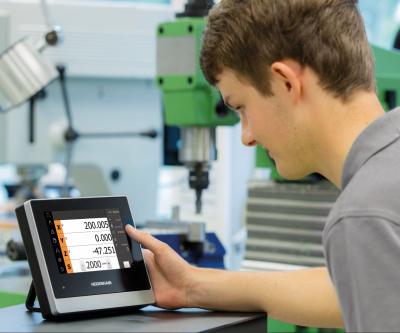
HEIDENHAIN’s newest digital readout (DRO) is now available to the market and promises to provide machinists with significant advantages and even more reliable tools to better utilize their manually operated machine tools (with up to four axes) than ever before. Called the ND 7013 model, this new DRO replaces the ever-popular ND 780 and offers an improved user interface and user-friendly touch screen, among other improvements.
This new ND 7013 DRO offers an improved status bar on the right side of the main screen that provides helpful options for selecting the respective operating status. A quick access menu allows the user to view or select multiple options such as displaying length and angle values, presets and tools, a stopwatch or calculator, feed rates, an edge finder (in milling mode), as well as an “auxiliary functions” key.
An I/O function is available on this new DRO providing additional useful enhancements for supporting machine functions.
The changeover from the conventional HEIDENHAIN keyboard to the touch screen facilitates operation and makes custom settings possible. This also provides increased protection from the ingress of dirt and liquids and thus improves suitability for a workshop environment.
The custom settings are done by configuring keys that are used to switch or control actuators in the machine. Furthermore, with a keystroke, a machinist can call documents (operating instructions, machine manual, tables) and display them on the screen. If spindle control is activated on the ND 7013 I/O, the user can also define keys for presetting the spindle speed. These custom-defined keys are then included in an OEM bar that can be dragged into the screen, if required.
Contact Details
Related Glossary Terms
- edge finder
edge finder
Gage mounted in the spindle of a vertical mill and used, while rotating, to find the center of a part relative to the toolholder.
- feed
feed
Rate of change of position of the tool as a whole, relative to the workpiece while cutting.
- gang cutting ( milling)
gang cutting ( milling)
Machining with several cutters mounted on a single arbor, generally for simultaneous cutting.
- milling
milling
Machining operation in which metal or other material is removed by applying power to a rotating cutter. In vertical milling, the cutting tool is mounted vertically on the spindle. In horizontal milling, the cutting tool is mounted horizontally, either directly on the spindle or on an arbor. Horizontal milling is further broken down into conventional milling, where the cutter rotates opposite the direction of feed, or “up” into the workpiece; and climb milling, where the cutter rotates in the direction of feed, or “down” into the workpiece. Milling operations include plane or surface milling, endmilling, facemilling, angle milling, form milling and profiling.

